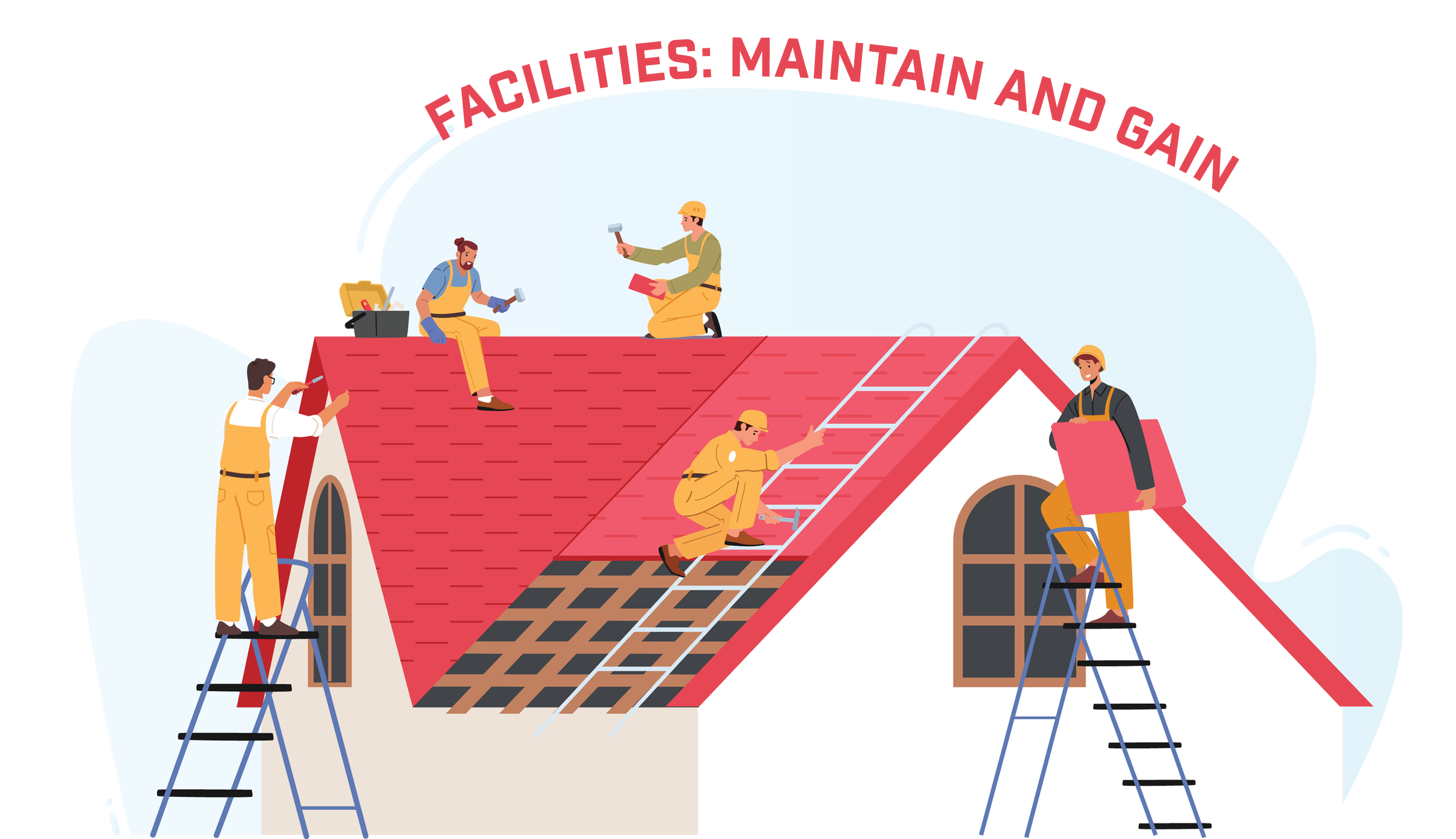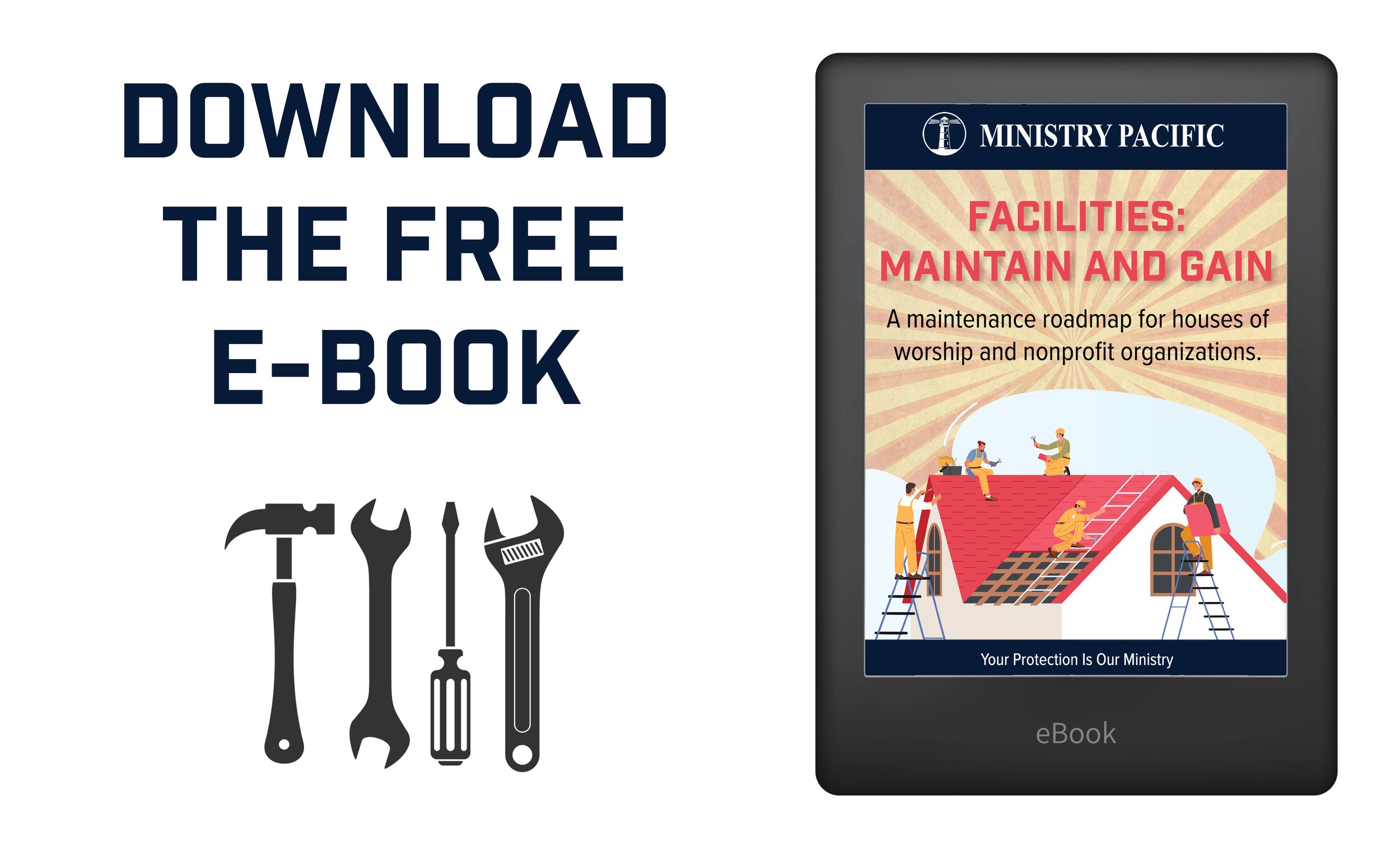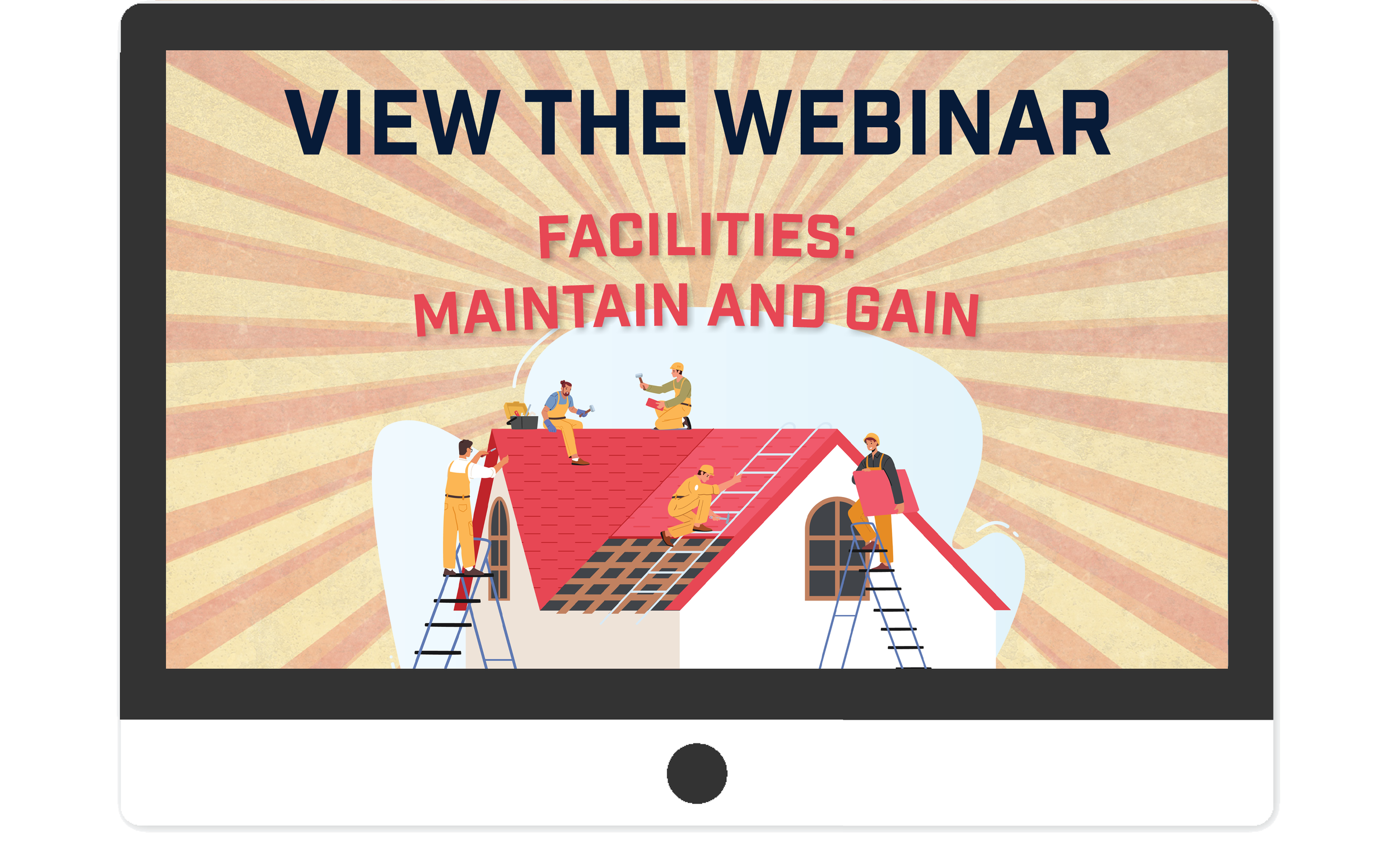Facility maintenance reduces risk – and claims
As Ben Franklin said, “An ounce of prevention is worth a pound of cure.”
Facility upkeep seems like a great idea – at least until we get to the fine print. Does it mean fixing things after they break? Or making sure they don’t break in the first place? Proactive maintenance requires a continual investment of resources. Sometimes, once this is understood, the commitment to maintenance stalls out: “Sure, it’s a good idea, but we’ll take up another day.”
Meanwhile, facility decay continues. That means minor problems – such as a slow dripping leak – may turn into full-blown hazards. Managing breakdowns is more expensive and chaotic than taking a proactive approach. So how do we turn a desire for a well-maintained facility into reality? Resources on this page are designed to help houses of worship and nonprofit organizations create a system that works for their unique organizations. There’s not just one approach. What’s important is to have one and do something.
More benefits
When churches and nonprofit organizations protect their property, it also reduces the need to file insurance claims. While a claim covers repair costs, it may also eventually lead to higher insurance rates. Conversely, churches that take a proactive approach to maintenance may obtain more competitive rates. They’ll also have the added benefit of preventing facility catastrophes.
What are the key areas to focus on?
While this list is not comprehensive, it includes some of the most common facility failures:
water damage
Water damage is the leading threat to facilities. Limit it by:
Knowing the location of the main shutoff valve + purchasing an automatic shutoff.
Routinely checking plumbing for leaks; monitor your building for mold, puddles and drips.
Routinely inspecting your sump pump and enabling a battery backup.
Keeping the temperature above 55 F to prevent pipe bursts.
Installing a sewage backup emergency shutoff to prevent inflow during heavy rain.
Keeping gutters and downspouts clear.
FIRE PROTECTION AND CARBON MONOXIDE
Make your fire department your ally. Ask for an inspection and advice.
Know what’s behind the walls. Wiring in historic buildings may be vulnerable.
Regularly inspect, test and replace smoke detectors.
Inspect fire extinguishers and fire suppression systems annually.
Inspect the electrical system periodically.
Store flammable materials properly.
Have a clear fire evacuation plan that is understood and practiced by staff and volunteers.
Carbon monoxide safety
Install detectors.
Don’t use gas appliances for heat.
If leaks are detected, fix them before re-occupancy.
ELECTRICAL SAFETY
Unplug equipment during storms.
Install appliance-grade surge protectors for sensitive equipment.
Consider a commercial surge protector to shield your entire electrical system.
Don’t overload outlets.
VANDALISM PREVENTION
Add lights to parking lots, entrances and exits. Install motion lights inside and out.
Install surveillance cameras.
Install a security system.
Consider an entrance/exit gate to prevent after-hours vehicle access.
Consider converting keys to keypads.
SLIP-AND-FALL PREVENTION
Regularly inspect for uneven surfaces and cracks. Identify and repair banisters and fixtures that may fail.
Use signs to alert of hazards, including wet floors.
Proactively clear snow and ice.
Webinar Discussion on Church Facilities: Maintain and Gain
This webinar, featuring Matthew Olphin of Glatfelter Public Entities Client Risk Solutions team, focuses on the practical aspects of facility maintenance.
OVERVIEW
🏢 Roof Maintenance is Critical: Roofs are the most common source of major losses in houses of worship. Wind damage combined with rain can lead to water intrusion, mold, and extensive interior damage. Organizations should know their roof's age, condition, and replacement timeline, and conduct regular inspections by qualified contractors.
⚡ Electrical Systems Pose Fire Risks: Older buildings often have unmaintained electrical systems with hazards like loose connections, arcing, and outdated equipment (such as Federal Pacific stab lock breakers). Regular electrical inspections and maintenance are essential to prevent fires.
💧 Water Damage from Plumbing Failures: Failed valves and old plumbing systems have resulted in multiple gym floor replacements at single facilities. Even simple issues like unattended faucets can cause significant damage. Regular plumbing inspections and maintenance are necessary preventative measures.
🚒 Fire Suppression Systems Require Maintenance: Fire pumps in sprinkler systems need weekly, monthly, and annual maintenance. Non-functional fire pumps during actual fires can result in significantly worse outcomes and greater property loss.
🔥 Wildfire Preparedness Involves Building Hardening: Beyond traditional maintenance, organizations in wildfire-prone areas must clear gutters of debris, maintain defensible space around buildings, control vegetation, and ensure roofs are in good condition to resist ember intrusion.
👔 Leadership Buy-In is Essential: Facility maintenance initiatives must start at the top of the organization. Without leadership commitment to budgeting and resource allocation, maintenance efforts will stall and fail. Leadership changes can disrupt ongoing maintenance programs if not properly documented.
💰 Budget Allocation is Non-Negotiable: Organizations must establish annual maintenance line items in their budgets and develop multi-year capital improvement plans. Deferring maintenance costs today results in exponentially higher expenses later – one prospective church client faced an approximately $10 million roof replacement bill due to years of deferred maintenance.
📋 Documentation Systems Prevent Loss of Continuity: Maintenance records should be centralized, backed up and easily accessible to new leadership. Simple systems (Excel spreadsheets, Access databases, or even three-ring binders with photos) work better than complex software for smaller organizations.
👥 Leverage Congregant Expertise: Many congregation members possess valuable skills in maintenance, HVAC, roofing, electrical work, and facilities management but may not feel engaged in traditional ministry roles. Creating building committees and delegating maintenance oversight provides meaningful engagement opportunities while utilizing available expertise.
🛠️ Establish Relationships with Qualified Contractors: Rather than hiring "a friend of a friend," organizations should obtain multiple bids, seek referrals from other churches and organizations, and build long-term relationships with reputable contractors. Professional contractors can identify issues (like hail damage) that untrained eyes might miss.
📊 Free Resources Are Readily Available: Glatfelter and partner organizations (like Hartford Steam Boiler's HSB Efficiency First website) offer free roofing self-assessments, electrical self-assessments, equipment care checklists, and other resources. Insurance agents and companies can provide guidance and documentation templates.
🚫 Avoid Unsafe DIY Inspections: While self-assessments are valuable, organizations should not send untrained volunteers onto steep roofs or to inspect electrical systems. Drones and professional contractors are safer alternatives for high-risk inspections.
📈 Losses Directly Impact Insurance Premiums: While insurance companies don't typically offer direct discounts for specific maintenance actions, the frequency and severity of losses directly affect premium rates. Demonstrating proactive risk management through documentation can positively influence underwriting decisions.
🎯 Insurance is Risk Management, Not Risk Elimination: Insurance policies are designed to manage risk, not eliminate it or serve as a substitute for proper facility maintenance. Insurance is a partnership requiring the organization to maintain reasonable care of its facilities. Neglecting maintenance may impact coverage.
🔐 Security Measures Prevent Additional Losses: Beyond structural maintenance, organizations should assess security risks including break-ins, vandalism, and arson. Cameras, motion sensors, alarm systems, and central station monitoring can prevent or mitigate losses, particularly for rural locations.
🎓 Start Simple and Evolve: Organizations don't need complex asset management software to begin. A simple one-page document listing the age and maintenance status of major systems (roof, electrical, plumbing, HVAC) demonstrates proactive management. Systems can become more sophisticated as the organization grows.
🚧 Identify and Assess Before Acting: The risk management process involves three steps: identification (what are our problems?), assessment (what do they mean?), and control (what will we do about it?). This structured approach helps prioritize efforts and budget allocation.
🏭 Facility Loss Disrupts Mission: The worst-case scenario is complete loss of a building, which stops the organization's mission, worship services, and community programs. Even partial losses requiring remediation and renovation can disrupt services for weeks or months. Preventative maintenance protects the organization's ability to fulfill its purpose.
🤝 Community Collaboration Reduces Costs: Organizations can learn from peers about contractor recommendations, project costs, and best practices. Networking with other churches and nonprofits provides valuable insights without requiring expensive consulting services.
⏰ Timing and Labor Costs Matter: Current construction industry challenges include labor shortages, extended lead times, and rising costs. Organizations should avoid rushing projects and should plan major renovations well in advance. The adage "fast, cheap, or good—pick two" applies to construction work.







